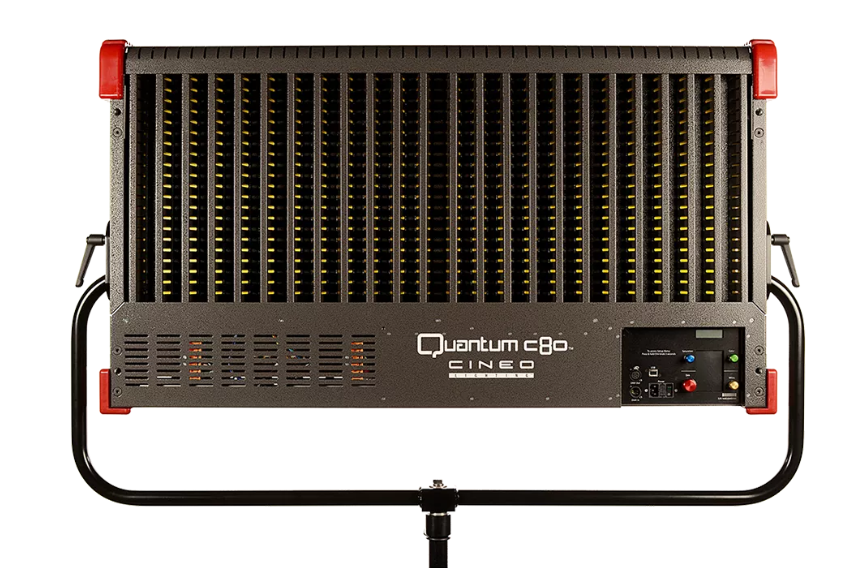The Combined White and Saturated Color LED Features a Unique GUI and No-Shift Light Without Gels
High-output, compact LED set lights from Cineo Lighting are known for their balanced, color-correct and natural-looking white and colored spectrum, as well as the way they dial in seamlessly on green-screen shoots. Cineo’s Quantum 120, one of the brightest soft lights on the rental and retail market at 75,000 lumens, features color temp presets from 2700K–6000K and has been used on creator and star Will Forte’s heavily green-screened post-apocalyptic comedy Last Man on Earth since 2015.
In late May, NBCUniversal and Cineo reached a deal to develop new LightBlade by Cineo technology and LED production fixtures for NBCUniversal’s broadcast, episodic and feature film productions. Cineo uses a proprietary technique to bring phosphor-converted white and color light to LEDs, rendering a range of believable lighting conditions, from deeply saturated to soft daylight.
We spoke with CEO Rich Pierceall about the company’s new Qc80, an award-winning 50,000-lumen saturated color LED fixture introduced earlier this year, to learn more about features that let lighting pros independently control everything from white and colored light to the dimming curve and saturation.
StudioDaily: The Qc80 is Cineo’s first foray into combination white and fully saturated color LEDs. Did you have to make any trade-offs to combine the two?
Rich Pierceall: We don’t compromise the white at all. Like some of our other popular lights, the Qc80 features variable white from 2700K–6500K. You determine the white point you’ll use based on the camera and what you want to shoot at, be it 3200K, or daylight, whatever. The white in the LED is derived from the same phosphor formulation and recipes that Cineo developed years ago in our remote phosphors — we’re the guys who invented remote phosphors — so all of our products match in terms of white. They are also all above 95 CRI at all color points. As we started to take our products into full saturated colors as well, it’s a completely separate system in the fixture. We have a full white and a full color system in there and they work in combination. That way you can set your white point for the DP independently of what you also are going to do with saturated color. They are two different kind of light and color philosophies and therefore need to be distinct and independently tunable systems. You determine what your CCT will be on white, then you work color into it. That’s very different from other LED fixtures.
How does that affect the life of the product when using white and saturated color together, and how does that compare to other LEDs out there?
There’s an interesting term called “differential aging,” which means that different LEDs will age at different rates due to the dyes in the LEDs. A green LED, for example, will age differently than a red LED. What we decided to do was use the same LEDs for all five colors. How we’ve done that is we’ve used phosphor, obviously, to convert blue LEDs into our white light formation. We’ve also used blue LEDs to convert our saturated colors as well: we’re doing a phosphor-converted red, a phosphor-converted green and the same blue dye we’re using everywhere else. All of our LEDs are the same, so they all age the same way. What does that means on set? Over time, there is no shift in color when using the same LEDs on a show because there is no differential aging. Again, that’s very, very different from our competitors’ products.
What are your customers saying about the Qc80 so far?
People don’t react so much to this kind of nitty-gritty differential aging stuff, though they are happy to know about it. It’s important to us and we designed them that way basically to support the longevity of the product. But the thing that people really got about this light at NAB and CineGear is its graphical user interface. We designed this GUI so that you really understand, and can see, what you’re doing when you’re adding color to white. Let’s be honest: not all lighting professionals are that familiar in working with light in color. They are familiar with gel, but gel is different because it subtracts light. What we’re doing here is additive, so we needed to have an easy-to-understand tool to allow you to work these color and white systems together. And they really love how the GUI lets them do that. That’s been the most common and strongest positive reaction from customers so far — just how easy it is to use.
Tell me more about the NBCUniversal partnership.
We have a pretty aggressive build plan with them that will be ongoing for the next five years. They showed those first LightBlade LEDs at CineGear in the NBCUniversal booth. They are serious about maximizing LED technology and we’re thrilled to be able to do it with them. We’ve had relationships with them for a while. They were in a tough situation before we started working with them, where the lighting products they were using weren’t evolving with the technology. So they had to decide, ‘Do we keep investing in what we have and try to stay current, or do we shift gears and work with a company that’s pushing the envelope a little harder?’ I like to think that’s how people see Cineo, because we are constantly pushing the edge and trying to find and develop new technology, as well as more robust manufacturing techniques. NBCUniversal looked at a bunch of other companies, including us, but I think because we make that innovation the centerpiece of our business, that was exactly what they were looking for and where they wanted to head next.
Cineo will show the Qc80 at IBC in Amsterdam, as well as premiere the Standard 410 (S410), a 25,000-lumen LED that weighs under 27 pounds.

